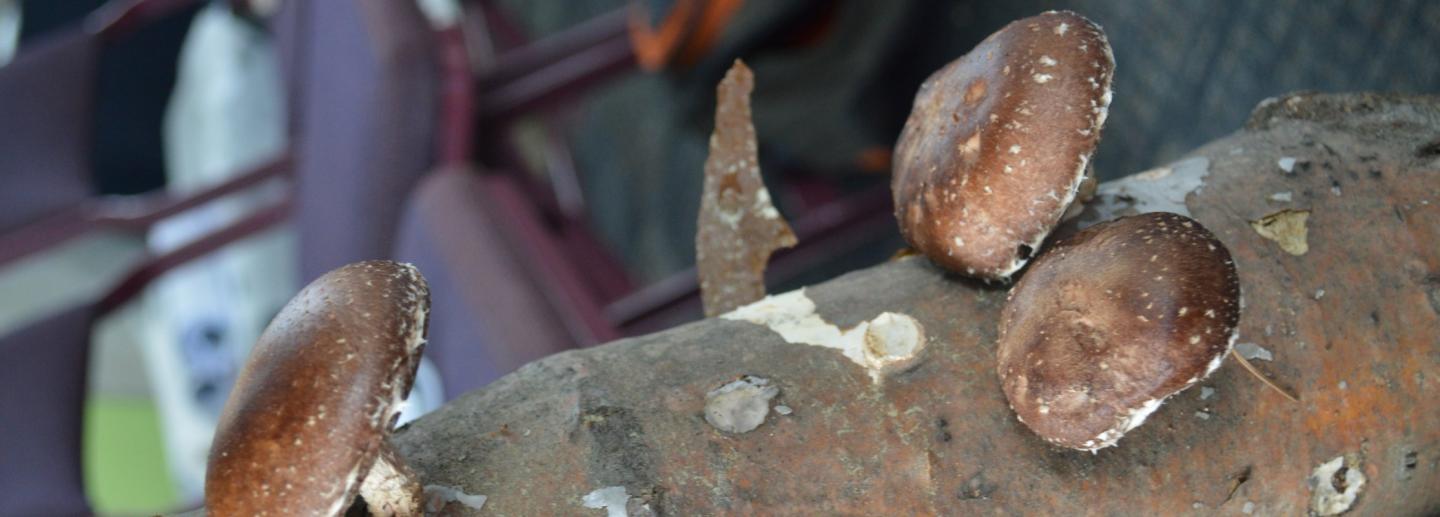In a small corner of High Falls, New York, farming happens under the shady canopy of a forest.
Here, spring peepers sing their chirpy chorus in hopes of wooing a mate.
Within the din, stacks of 40-inch logs sit quietly, waiting to be soaked in a cold water bath.
From that bracing baptism will spawn the fruit of this low-intensity form of farming—shiitakes, oysters, and other mushrooms ready for consumption or sale.
“I love working in the mushroom yard,” Dyami Soloviev said.
Soloviev and her business partner, Krista Marshall, grow mushrooms at High Falls Farm in Ulster County.
They produce mushrooms for sale to local restaurants and through community-supported agriculture (CSA) shares. Soloviev and Marshall also sell logs pre-injected with mushroom spawn as holiday gifts.
They honed their business in consultation with Steve Gabriel, an author, farmer, and agroforestry specialist with Cornell University’s Small Farms Program, who has led forest farming workshops at the Omega Center for Sustainable Living (OCSL).
Shiitakes Are In Short Supply
Mushrooms grown outdoors on logs, also called bolts, are in high demand. One study found that nine out of 10 producers of forest-grown shiitake mushrooms in the Northeast could not meet demand for their product.
“It’s all about quality,” Gabriel said. “Why does someone pay double for an heirloom tomato compared to an indoor-grown tomato that looks pale? The quality and taste is what drives the interest, as well as the fact that the mushrooms are grown outside naturally in the woods.”
Indeed, mushroom farming requires no chemical inputs. There is no spraying.
All that is needed is a log, a drill, some spawn, and some wax to cover the holes into which the spawn is placed.
Wait a year—less if you are in a warmer climate. Then soak the logs in cold water. In five to seven days, you have mushrooms ready to be harvested.
Each log will generate a new mushroom crop every seven weeks or so for up to three years.
Operations can vary in size, from the hobbyist to someone looking to create a small business.
“I know some folks,” Gabriel said, “who just retired and say it sounds like a fun thing to do and would be great if they could make a little spending money.”
John Michelotti founded Catskill Fungi after taking part in an OCSL program that featured Gabriel.
“At our family farm, we cultivate medicinal mushrooms and make them into health tinctures that we sell at stores,” Michelotti said.
Mushrooms are not the only crop found in the forest. Tree sap and wild plants, such as elderberry, are easily attainable and can be marketed as well.
Profit Is Not the Only Benefit
However, it’s not all about money.
There is a larger goal sought by those who practice agroforestry from a regenerative perspective.
Beyond growing mushrooms, more and more forest farmers are understanding how their practices can improve natural systems.
Mushroom production requires logs, or bolts, that are harvested from downed trees. Thinning of certain trees can improve long-term forest ecology.
For example, in stands where beech trees are threatened by beech bark disease, farmers can harvest diseased trees for mushroom logs, opening up space for less threatened hardwood species.
That, in turn, promotes food for wildlife and then, wildlife diversity.
“A forest will certainly do its thing and slowly evolve,” Soloviev said. “But we can play a role in its evolution. Someone who has a trained eye can coax long-term forest health.”
“I want,” Michelotti said, “to leave this earth better than I found it.”



